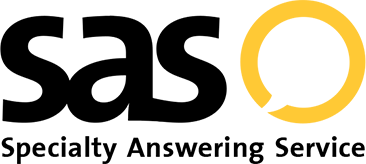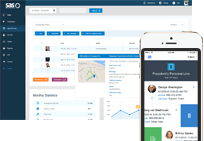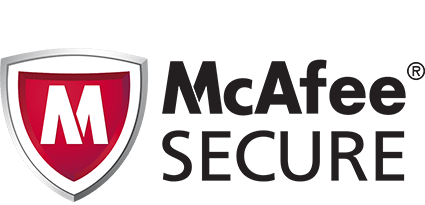- Log In
- Support
- Company
- Contact Us
- Live answers @ 1-888-532-4794
Infographic: How Call Centers Use Natural Language Processing (NLP)
When you call a business and the automated attendant at the call center picks up and asks how they can be of service, did you ever wonder how the computer can understand what you are talking about? You could say anything from, “I need my account balance,” to, “I want a refund!” and magically, the system understands what you’re talking about and gets you the help you need. That’s all thanks to Natural Language Processing, or NLP for short.
To learn more about the history of Natural Language processing and how the technology has evolved and been adopted in call centers, check out the infographic below.
Natural language improves customer service by allowing customers to speak in context, rather than offering them pre-defined choices. In the call center, NLP combined with IVR systems:
- Improves First Call Resolution by intelligently routing callers to the agents who can provide the highest level of support with respect to their specific issue.
- Minimizes agent search time or script navigation through intelligent routing.
- Enhances customer service by offering a self-service model, as well as an easy route to access superstar agents for help.
To learn more about the history of natural language processing and its use in answering services, we invite you to read our white paper.
If you’re writing about NLP on your own website, please copy the code below to use this infographic:
[html]
<img title=”Natural Language Processing Infographic” alt=”Natural Language Processing Infographic” src=”https://www.specialtyansweringservice.net/wp-content/uploads/natural-language-processing-infographic.jpg” width=”771″ height=”6531″ />
<pre><em>Image originally posted on <a href=”https://www.specialtyansweringservice.net/infographic-how-call-centers-use-natural-language-processing/”>The SAS Blog</a></em>
[/html]
Introduction
Natural Language Processing (NLP)
- AKA Natural Language Understanding, Natural Language Technology, Natural Language
- Contact centers’ answer to developing high-end speech based solutions
- Improves customer service by allowing caller to speak in context rather than pre-defined choices
- Computerized analysis of natural text and speech
- Achieves human-like language processing for a variety of applications
NLP-Based Systems in Call Centers
- Used in speech recognition and interactive voice response (IVR) to provide natural interactions with callers
- Uses a rule base to define how the system responds to callers
- Guides calls through a transaction without restricting language
- Natural language engages callers in human-like conversation that is intuitive and smooth
A full-fledged NLP system can perform the following functions:
- Paraphrase and input text
- Translate a given text into another language
- Provide contextual responses based on the text contents
- Draw inferences from the text (still a challenge in many cases)
The Need for Speech Enabled Automation
- IVR systems reduce costs through automated customer self-service
- Initially, IVR only used touchtone, limiting callers to simple self-service tasks
- Today, speech-enabled IVR allows complex tasks as self-service transactions
- Success of self-service systems is determined by accuracy of speech recognition
However, noisy backgrounds, heavy accents, and unintelligible responses make transactions difficult.
Speaking the Customer’s Language
- Callers typically explain their problem in their own unique vocabulary
- IVR systems interpret the customer’s need by decoding their vocabulary
- Before NLP, speech recognition relied on pre-defined grammar (a list of acceptable phrases that IVR systems are programmed to recognize)
- Pre-defined grammar only works if callers stick to defined phrases
- Systems cannot correctly interpret speech that is out-of-grammar. This leads to caller dissatisfaction, increased call handling time, and increased expenses
- Out-of-grammar errors are almost 5x that of misrecognition errors.
NLP improves IVR accuracy, increases automation, and improves customer satisfaction by:
- Enlarging the grammar
- Spotting keywords
Statistical Modeling
- High-end NLP does not rely on pre-defined grammer based matching for recognition
- Instead, statistical modeling identifies key phrases and context, allowing the system to ask callers open-ended questions
- If the user gives an unexpected response such as “hamburger,” there will be no match. Note that systems can be configured to fall back to a traditional approach with a pre-defined set of alternatives
History and Evolution
Research dates back to the late 40’s.
- During war years, Machine Translation (MT) projects were initiated based on language analysis, obtained by breaking down enemy codes
- Early systems used dictionary look-up for word translation, then re-ordered the words to match the rules of the target language
- In 1957, Chomsky published Syntactic Structures, which introduced generative grammer
- Prototype systems were built to demonstrate the effectiveness of specific theories
- Theoretical contributions included:
- Case Grammar by Fillmore
- Schank’s Conceptual Dependency Theory
- Wood’s Augmented Transition Networks
- The Semantic Networks of Quillian
- Kay’s Functional Grammar
- NLP has grown rapidly, due to an increase in electronic text, computational power and memory, and the internet
In-depth knowledge about language structure (vocabulary, how words combine to form phrases, meaning of the words, and how words combine to give meaning to sentences). Systems must have a practical knowledge of the world around us, and our reasoning based on language.
Levels of language define NLP systems
- Phonology: deals with interpretation of sounds within and across words
- Morphology: deals with morphemes, the smallest meaningful units in a word
- Lexical: the meaning of individual words are interpreted
- Syntactic: grammatical structures (syntax) is identified by analyzing words in a sentence
- Semantic: deciphers words with multiple meanings, focuses on meanings of a sentence by analyzing the interactions between it’s words
- Discourse: works with units of text that are larger than a sentence
- Pragmatic focuses on situational use of language; context of usage is more relevant that content of text
Technology
NLP has four approaches:
- Statistical Approach: uses statistical and mathematical models for NLP
- Connectionist Approach: develops generalized models from specific examples of linguistic phenomena
- Symbolic Approach: based on human’s language rules and lexicons; analyzes linguistics using knowledge schemes that represent facts about language
Advantages of NLP Based Applications
Contact centers can provide more targeted answers to customer queries without agents having to manually search for answers. This:
- Increases first call resolution
- Minimizes agent search time
- Improves collaboration
- Enhances customer satisfaction
Categories
- Advice (32)
- Answering Service 101 (18)
- Best Practices (10)
- Call Center Jobs (6)
- Call Center Software (20)
- Comparison (2)
- Customer Service (30)
- Funny (31)
- Holidays (19)
- Industry Hacks (19)
- Infographics (53)
- International (1)
- Medical (8)
- News (12)
- Phone Etiquette (2)
- Phones (14)
- Pricing (8)
- Quizzes (3)
- Receptionist (11)
- SAS Products (29)
- Scripting (4)
- Services (5)
- Small Business (25)
- Starting Up (7)
- Tips and Tricks (19)
- Uncategorized (1)
- Videos (19)
- Workplace (6)
Recently writen
- Call Center Script Best Practices: Advanced Script Block Tips to Optimize Your Answering Service
- January 2025 Release Notes – Adjustments to Call Details Timeline, New Scripting Updates, Live Transcription, and more!
- April 2024 Release Notes – Voicemail Greetings, Ability to Access Websites With a Username and Password, and more!
- March 2024 Release Notes – New Add-On, Settings Revamp, and more!
Follow Us
How about a demo?
We'll show you how our web portal works and answer any questions you have about SAS.
Schedule a demo








